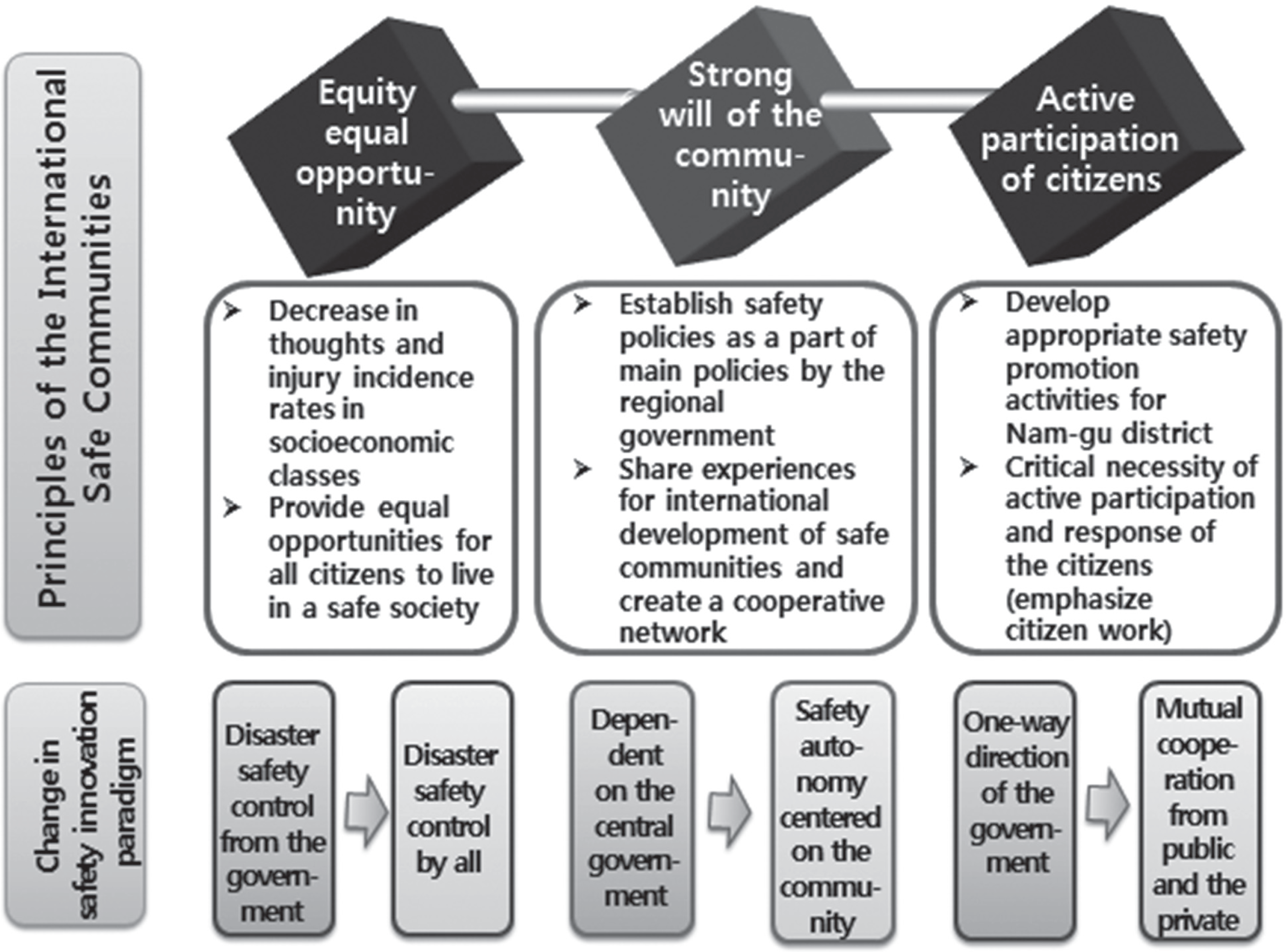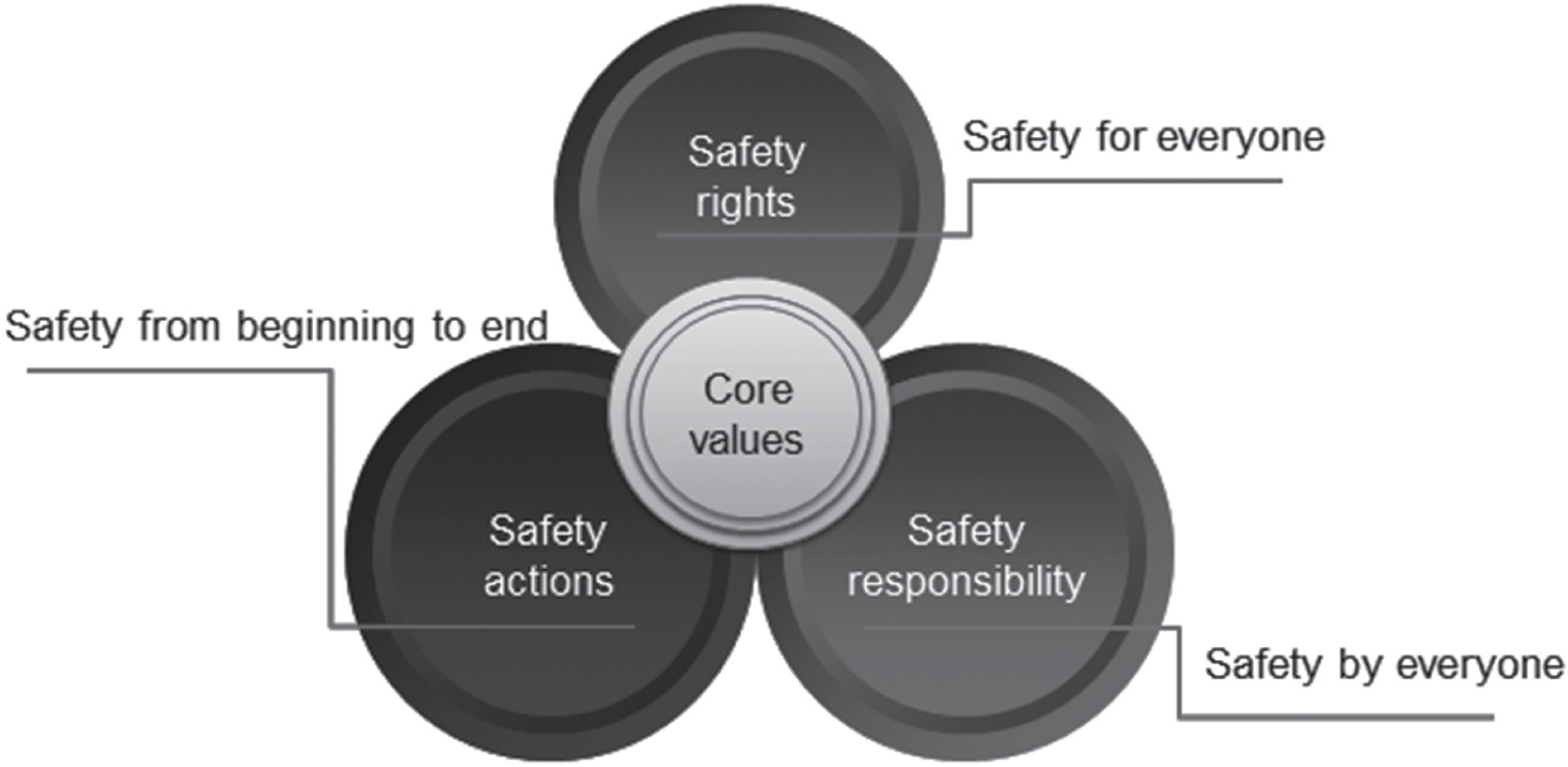Abstract
Purpose
Safety of humans is an important factor that affects health overall, and injuries are one of the major public-health problems in the world. The purposes of this study were to describe the International safe Community movement which contributes to the injury prevention and safety promotion all over the world, and to identify out the application and developmental strategies for Korea.
Methods
A review was done of previous research, reviews, and reports on the history, concepts, basic principles, and recommendations for actions of the Safe Community.
Results
For this study, the application strategies of the International Safe Community movement in Korea were examined to deduce the strengths of the safe Community program. Community-based injury prevention work according to the International Safe Community model is a successful and cost-effective way of reducing injuries in the community.
Conclusion
Through the International Safe Community program, communities are able to realize a healthy community and achieve improved quality of lives for the people, which is the ultimate objective of the Safe Community model. In addition, it will contribute to the economic vitalization and gain through energy and enhancement of productivity of people.
References
1. Svanström L, Haglund BJA. Evidence-based safety promotion and injury prevention-an introduction [Internet]. Stockholm, SE: Karolinska Institutet;2000. [cited 2015 October 12]. Available from:. http://www.ki.se/csp/pdf/Books/EvidenceBasedSkadepre-vEngvers.pdf.
2. Jansson B. Festschrift in honour a safe community-a tribute to Leif Svanström. International Journal of Injury Control and Safety Promotion. 2012; 19(3):189–191. http://dx.doi.org/10.1080/17457300.2012.709724.
3. Kendrick D, Young B, Mason-Jones AJ, Ilyas N, Achana FA, Cooper NJ, et al. Home safety education and provision of safety equipment for injury prevention (Review). Evidence-Based Child Health. 2013; 8(3):761–939. http://dx.doi.org/10.1002/ebch.1911.

4. World Health Organization. Human factors in patient safety review of topics and tools [Internet]. Geneva, CH: Author;2009. [cited 2015 October 12]. Available from:. http://www.who.int/patient-safety/research/methods_measures/human_factors/human_factors_review.pdf.
5. Welander G, Svanström L, Ekman R. Safety promotion-an introduction. 2nd ed. Stockholm, SE: Karolinska Institutet;2004.
6. World Health Organization Collaborating Centre on Community Safety Promotion. How do we define a safe community? [Internet]. Stockholm, SE: Karolinska Institutet;2004. [cited 2009 August 16]. Available from:. http://www.phs.ki.se/csp/who_intro-duction_en.htm.
7. Mitchell R, Haddrill K. WHO safe communities-should we expand the definition of a ‘community’? International Journal of Injury Control and Safety Promotion. 2007; 14(1):60–63. http://dx.doi.org/10.1080/17457300600775585.

8. Nilsen P, Bourne M, Coggan C. Using local injury surveillance for community-based injury prevention: An analysis of Scandinavian WHO safe community and Canadian safe community foundation programmes. International Journal of Injury Control and Safety Promotion. 2007; 14(1):35–43. http://dx.doi.org/10.1080/17457300600864447.

9. Jansson B. Research on the prevention of fall injuries still makes prediction for practice difficult. Age and Ageing. 2007; 36(3):351–352. http://dx.doi.org/10.1093/ageing/afm027.

10. McClure RJ. Injury risk and prevention in context. Injury Prevention. 2010; 16(6):361–362. http://dx.doi.org/10.1136/ip.2010.028175.

11. Seedat M, McClure R, Suffla S, van Niekerk A. Developing the evidence-base for safe communities: A multi-level, partly randomised, controlled trial. International Journal of Injury Control and Safety Promotion. 2012; 19(3):231–241. http://dx.doi.org/10.1080/17457300.2012.705303.

12. World Health Organization. The Adelaide recommendations: Healthy public policy. Health Promotion International. 1988; 3(2):183–186. http://dx.doi.org/10.1093/heapro/3.2.183.
13. World Health Organization. Ottawa charter for health promotion. Health Promotion International. 1986; 1(4):405. http://dx.doi.org/10.1093/heapro/1.4.405-a.
14. World Health Organization Collaborating Centre on Community Safety Promotion. Manifesto for safe communities. Paper presented at The First World Conference on Accident and Injury Prevention. 1989. September 17-20; Stockholm, Sweden.
15. Svanström L. Evidence-based injury prevention and safety promotion: Some results. A chapter in the Report: Evidence-based injury prevention and safety promotion and Slutrapporten: Samh llets oly-cksbarn. F rslag till nationella j mlikhetsstrategier –lera skadefria r f r alla. Stockholm, SE: Sweden’s National Institute of Public Health;1998.
16. Butterfoss FD. Process evaluation for community participation. Annual Review of Public Health. 2006; 27:323–340. http://dx.doi.org/10.1146/annurev.publhealth.27.021405.102207.

17. Svanström L. It all started in Falk ping, Sweden: Safe Communities-global thinking and local action for safety. International Journal of Injury Control and Safety Promotion. 2012; 19(3):202–208. http://dx.doi.org/10.1080/17457300.2012.696661.
18. Ekman R, Ekman DS, Schyllander J, Schelp L. A comparison of unintentional injury patterns occurring in two Swedish communities in 1978 and in 2008. International Journal of Injury Control and Safety Promotion. 2015; 22(3):254–259. http://dx.doi.org/10.1080/17457300.2014.918153.

19. Rahim Y. Safe community in different settings. International Journal of Injury Control and Safety Promotion. 2005; 12(2):105–112. http://dx.doi.org/10.1080/17457300500089954.

20. Lindqvist K. Motala municipality-a sustainable safe community in Sweden. International Journal of Injury Control and Safety Promotion. 2012; 19(3):249–259. http://dx.doi.org/10.1080/17457300.2012.692692.
Figure 2.
Prosecution principle of the International Safe Communities movement in accordance with the safety innovation paradigm of the Korean government.

Table 1.
Strategies of the Safety Innovation Master Plan in Compliance with the International Safe Communities Designation Indicators




 PDF
PDF ePub
ePub Citation
Citation Print
Print



 XML Download
XML Download